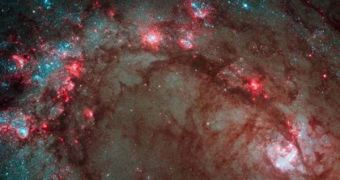Some of the most massive galaxies in the Universe, the Milky Way included, grew to their incredible sizes and masses by consuming, or cannibalizing, smaller galaxies that were unfortunate enough to be in their path. A study now shows this process in more detail, and in different places.
Dwarf galaxies, which are smaller, irregular agglomerations of stars that orbit around their larger brethren, are severely distorted when they are consumed, by the tidal and gravitational pull of their neighbors. They cannot resist, and their gas eventually unites with the other's.
In the new research, an international astronomical collaboration looked at the galaxy M63 (Messier 63), and especially at star streams that have been demonstrate to exist around it. These streams are in fact debris from a past dwarf galaxy, that was consumed by M64 a long time ago.
A galactic collision is not a simple or straightforward process. That is to say, galaxies don't simply slam into each other and merge. They first circle each other like eagles stock prey, and then they begin interacting slowly, in a ballet-like matter.
The process lasts for millions of years. Both suffer deformations, that are brought on by tidal interactions with the counterpart, but experience massive stellar growth spurts at the same time.
This happens because the hydrogen gas clouds contained within the colliding galaxies are stirred by the interactions, and forced to start collapsing again. As they do so, they create large numbers of stars.
Such a scenario takes place when a massive galaxy consumes a dwarf one, with the exception being the fact that it's the larger member of the duo that exerts most gravitational influences.
M63 was analyzed for this study by experts in Germany, at the Max Planck Institute for Astronomy (MPIA), who were led by researcher David Martínez-Delgado. The team also looked at other galaxies, located as far as 50 million light-years away from Earth, Daily Galaxy reports.
One of the most interesting mysteries surrounding dwarf galaxies is the fact that they can theoretically contain no dark matter, whereas practical observations show that they positively have to. Another weird thing is that all dwarf galaxies in our galaxy appear to be located in a single plane.
“If you watched a time-lapse movie of our galaxy, you would see a swarm of dwarf galaxies buzzing around it like bees around a beehive,” says expert Anna Frebel.
“Over time, those galaxies smashed together and mingled their stars to make one large galaxy -- the Milky Way,” adds the expert, who is based at the Harvard-Smithsonian Center for Astrophysics (CfA), in Massachusetts.

 14 DAY TRIAL //
14 DAY TRIAL //